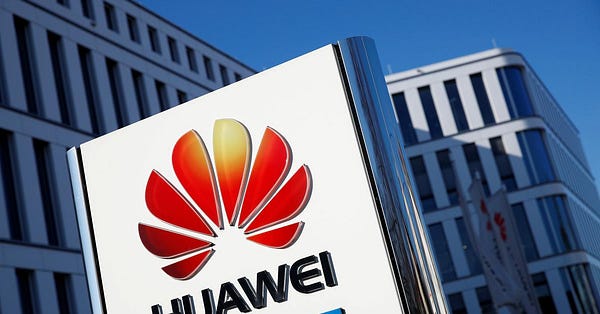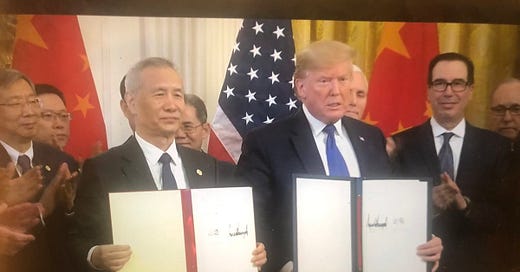Welcome to the first edition of “Trade War” to come after the supposed resolution of the trade war—or at least after the “phase one” deal that was signed last Wednesday. Of course the idea that there has been any serious resolution is, I’m afraid, nonsense. No one but the supremely gullible or willfully ignorant expect US-China trade frictions to now magically go away.
“Will you say, ‘Thank you, Mr. President’”
The “phase one” event itself was notable for its unusual tenor: while the visiting Chinese dignitaries led by Liu He stood in apparent befuddlement, Trump presided over a bizarre and rambling 75-minute long event that seemed focused on him calling out the names and congratulating the dozens of corporate chieftains in attendance, while simultaneously taking credit for the business success of many of them.
“Will you say, “Thank you, Mr. President” at least? Huh?” he said to one JPMorgan Chase exec, before bragging that “I made a lot of bankers look very good.” He continued in the same vein, later saying “most of you, I can say, you’re doing fantastically well. “Thank you, Mr. President.” Don’t worry about it. Don’t feel guilty.” Attendees included top execs from Honeywell, Boeing, Micron, Citibank, AIG, and many more.
Cheerleaders for outsourcing jobs to China
That didn’t resonate well with everyone, including those who focus on workers and jobs. “There were a lot of Wall Street guys and big cheerleaders for outsourcing jobs to China,” said Scott Paul of the Alliance for American Manufacturing, “I didn’t see many working-class folks in that room.”
“The only question that matters: does the US-China #tradedeal have enforceable penalties if workers are denied internationally recognized labor rights (esp independent unions & collective bargaining)?,” tweeted one researcher on China labor rights. “No? Then the US can't compete on manufacturing. *period* The rest is fluff.”

Look at our penmanship
In any case, Trump and top Chinese trade negotiator Liu He finally got to signing it and even showed their penmanship for the cameras, as pictured below:
The tally: 105 “China shall” vs. 5 “United States shall”
So what’s in the deal—a lot of “shalls” which were helpfully tallied up by one China watcher (the former head of the World Bank to China, in fact). Here’s what he found: 314 "shall" in total, 105 "China shall", 88 "parties shall" or "party shall" or "China and the United States shall", and only five "the United States shall"

Government dictates rather than market forces
Adds trade reporter David Lynch, writing in the Washington Post: “The deal reflected the president’s distinctive reshaping of American trade policy, relying on government dictates rather than market forces and establishing a direct enforcement system outside the World Trade Organization.”
For the first year, China has promised to buy an additional $76.7 billion in U.S. goods and services, up 41 percent jump compared to what it spent it spent on American exports in 2017, Lynch writes.
Also, notable: the fact that the agreement will not rely on independent parties to resolve any possible future disputes. “Rather it’s up to each side to decide on its own whether the other is violating its commitments. How this will play out remains to be seen,” Wendy Cutler, vice president of the Asia Society and a former U.S. trade negotiator, said to the Washington Post.
The bottom line
While the agreement does indeed have the Chinese promising to buy more, it focuses much more on a managed trade approach than on trying to solve the serious systemic issues that have long upset US and foreign investors in China—industrial subsidies benefitting Chinese state enterprises and restrictions on foreign investment in many industries, to cite just . two that were left largely untouched.
“The agreement is a limited one, primarily capping the potential for further escalation of protectionism on both sides rather than taking serious steps to address long-standing issues in Chinese trade practices,” write the Rhodium Group’s Dan Rosen and Logan Wright, noting that while China has promised more US imports, its “capacity and willingness to meet these targets remains in question.” Meanwhile, “the broader decoupling trends in security-sensitive areas of the bilateral relationship will continue.”
“So-called” Phase 1
While it’s not surprising democrats, particularly those who hope to run against Trump for president later this year (see Biden below), are critical of the deal, even some of Trump’s usually sycophantic supporters are expressing their disproval. “This so-called Phase 1 agreement will make sure American capital continues to directly fund China’s state-run economy,” wrote Marco Rubio.


“China is the big winner,” says Biden
For a roundup of their views on China —not trade but general - of all the leading US democratic presidential candidates, here’s a helpful piece from Bethany Allen-Ebrahimian of Axios (as she point out, they are all “short on details”):


Meanwhile, U.S. is still going after Huawei, trade deal or not…


And China is sticking with Made in China, its sweeping industrial strategy…


US manufacturing says ‘No thank you, Mr. President’?


And is even in recession…
“US manufacturing was in a recession in 2019, according to Fed data out today,” writes Heather Long, economics reporter at the Washington Post, on January 18. “Output declined last year. Job growth slowed sharply. Job openings fell 32% since July. It's the sore spot in the US economy.”


Disappointed US soybean farmers
“A lot of American farmers are going to be disappointed with this trade agreement. Soybean prices are plummeting after the deal failed to include a specific $ amount for China's purchases of U.S. soy. All this just a few months before planting season!” writes Bloomberg’s Tracy Alloway.


And then you got global trade
It was down last year for the first time since the 2008-2009 global financial crisis..
Notable/In Depth
Watch the movie! The Peterson Institute for International Economics has made a short video about the tariffs:


Worth checking out what looks like a bunch of interesting articles from experts on trade wars, in the Journal of International Economic Law:


What lobster sales tell us about the trade deal: Maine’s live lobster sales to China fell dramatically in the twelve months after tariffs were imposed in July 2018—down by 46.7 percent—as Chinese buyers instead turned to Canadian lobster. But will “phase one” make a difference? Much as with soybeans and other products, no one is really sure.
“The deal includes a commitment that China will purchase lobster in the coming years – but I am concerned the language does not appear to specify a minimum purchase amount, nor does it remove the existing tariffs so our lobster can be competitively priced with Canadian lobster,” frets Sen. Angus King in the Portland Press Herald.
Finally a big new report is out on China’s Belt and Road Initiative, the massive state-led push to expand economic power overseas, highlighting how it is strengthening China Inc. “China’s colossal national champions—boosted by state-aid and cheap financing—are securing an unusually large proportion of contracts when compared to multilateral development schemes,” said Joerg Wuttke, president of the European Union Chamber of Commerce in China.






